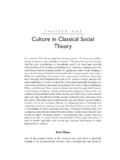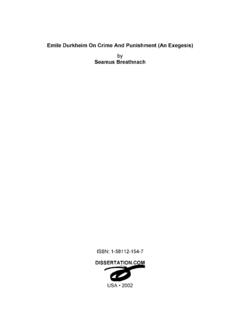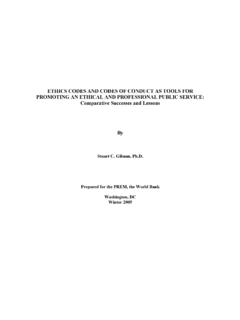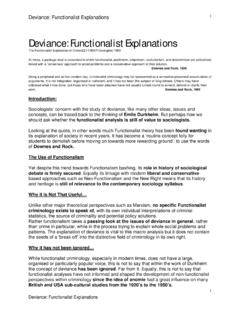Transcription of BEST PRACTICES IN SUBSTANCE ABUSE …
1 RESEARCH FINDINGS AND best PRACTICES IN. SUBSTANCE ABUSE TREATMENT FOR OFFENDERS. A Review of the Literature Prepared for the NC DOC SUBSTANCE ABUSE Advisory Council North Carolina Department of Correction Office of Research and Planning Sandy C. Pearce, Manager Douglas Holbrook, Analyst August 2002. Treating Offenders with Alcohol and Other Drug Dependencies The research literature and best PRACTICES literature uses a variety of terms to refer to treatment for excessive alcohol and drug use: alcohol and other drug dependency (AOD) treatment; chemical dependency treatment; SUBSTANCE ABUSE treatment. In this review, the terms are used as the researchers/authors reference them. The purpose of SUBSTANCE ABUSE treatment for offenders is to stop the alcohol and/or other drug ABUSE and to return the individual to productive functioning in the family, workplace, and community.
2 Measures of effectiveness typically include levels of alcohol and/or other drug use, criminal behavior, family functioning, employability, and medical conditions (NIDA, 1999). This report provides a summary of the research literature on offender SUBSTANCE ABUSE programs and a description of best PRACTICES literature. Risk, Needs and Responsivity Andrews, Bonta, and Hoge (1990) describe a science-based correctional model for assessing and intervening with alcohol and other drug dependencies that uses the assessment of the individual to drive the treatment plan. This model is founded on the principles of risk, needs and responsivity. The risk principle . states that the most costly and intensive resources should be reserved for the highest-risk cases.
3 High-risk offenders have more to gain from treatment in terms of reducing their risk for future involvement in crime. The need principle . states that future criminal activity can be reduced by identifying and intervening with the criminogenic or crime-producing needs of the offender. Research indicates that criminogenic needs include cognitive (thinking) distortions, deficits in problem-solving ability, egocentricity, employability, SUBSTANCE ABUSE and antisocial attitudes, sentiments and values. The responsivity principle refers to offender characteristics that influence the offender's individual response to treatment. Examples of responsivity factors include the following: learning style, personality characteristics, and treatment motivation.
4 Research indicates that addressing these three areas with offenders, through assessment and individual treatment planning, can reduce recidivism (Andrews, 1995). Screening, Assessment, and Treatment Planning To provide effective services to offenders, treatment providers must understand the special characteristics of this population. Alcohol and other drug-involved 2. (AOD) offenders are not a homogenous group. These differences include personality, patterns of AOD ABUSE , health status, socialization, education, family, job training, urban and rural influences, and mental functioning. They range from seriously antisocial individuals to those who are more pro-social and have family and community support systems.
5 Therefore it is critical to screen and assess offenders prior to placing them in treatment programs. This screening and assessment should determine the range of services needed by the offender to learn to cope in society and should assist in developing an individualized case plan (CSAT, 1995). Screening and assessment is a multi-stage process. Screening is the initial activity that identifies offenders who are likely to have AOD problems. Many screening and tools exist to gauge an inmate's need for treatment services. Research indicates that inmates with SUBSTANCE ABUSE problems are at higher risk for a number of problems and conditions that, left unidentified and unaddressed, can increase the probability of relapse and reincarceration.
6 Screening instruments recommended by researchers for criminal justice populations include the Alcohol Dependence Scale and the Drug Use section of the Addiction Severity Index, the Texas Christian University Drug Dependence Screen, and the Simple Screening Instrument. They found these instruments to be superior to the SMAST and the SASSI (Rounds-Bryant et al., 2000). An assessment is a process that helps determine the extent of an individual's problem with alcohol and other drugs and the appropriate level of treatment. Assessments should be biopsychosocial in nature and should address medical, psychiatric, psychological, emotional, social, familial, nutritional, legal and vocational areas to determine the levels of treatment intervention and services that will be needed (CSAT,1995).
7 While AOD screening is generally a one-time event, an AOD assessment is an on-going process. Commonly used assessment instruments include the Offender Profile Index, which is used to determine the appropriate type of AOD. ABUSE treatment for the offender and the Addiction Severity Index, which is probably the most widely used standardized diagnostic instrument in the field. Assessment is repeated throughout treatment and throughout the offender's involvement in the criminal justice system. Changes in the offender's severity of addiction and in problems related to addiction, as well as new life problems and crises, require modifications in the treatment plan (CSAT,1995). CARF (2001), the Rehabilitation Accreditation Commission, promotes the quality, value, and optimal outcomes of rehabilitative services, according to their mission statement.
8 The Commission develops and maintains standards that enable rehabilitative programs to attain accreditation. These standards are consensus . standards from the involvement of providers, consumers, and purchasers of services. Screening, assessment, and case planning are required components of a criminal justice treatment program under CARF standards. 3. CARF standards require screening and require that qualified personnel conduct assessments. The assessor may draw information from the offender, family members, peers, and other collateral sources. The assessment should include, at a minimum, the following information on the offender: 1) age or developmental level 2) gender 3) sexual orientation 4) social preferences 5) cultural background 6) psychological characteristics 7) physical condition 8) spiritual beliefs 9) employment history 10) family history, and 11) history of ABUSE Case Management Case management is the process of linking offenders with needed services in the treatment system, including services other than AOD treatment.
9 Supplementary services can include medical, dental, mental healthcare, housing, education, and vocational training. Critical case management issues include identifying those who have a specific responsibility for the offender and those who make treatment decisions. Written agreement must be reached about the roles of involved parties. Cross training and memoranda of agreement between treatment providers and other providers is essential. There are various case management models case management provided by the justice system, case management provided by the treatment system, case management provided by a separate entity from the treatment or justice systems, and case management provided by multidisciplinary groups in the criminal justice system for offender management (CSAT, 1995).
10 The Treatment Accountability for Safer Communities (TASC) Program is a national model for case management. Case management in SUBSTANCE ABUSE as the process that links individuals in treatment with ancillary community services. It is often viewed as an adjunct to primary treatment and as an enhancement to treatment. Enhancements often include eliminating barriers to treatment participation, expanding access to complementary social services, making referrals and coordinating the services obtained, monitoring progress, adjusting plans as required, and serving as an advocate. TASC programs usually provide all of these elements of case management. TASC case management provides structured linkages between the criminal justice system and the treatment system.













